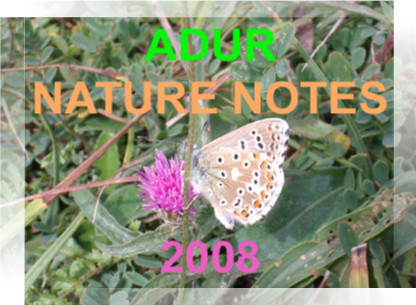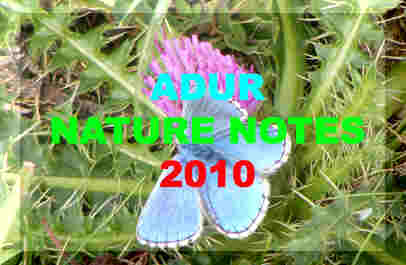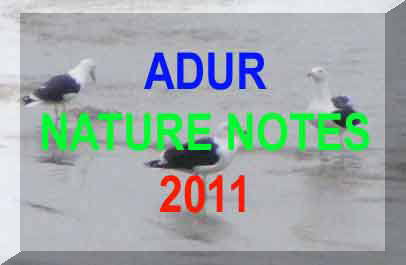

| 17
June 2019
7-spot
Ladybird
|
18
May 2019
A
14-spot Ladybird, Propylea quattuordecimpunctata,
landed
on me near the Tollbridge.
8 April
2019
Two
7-spot
Ladybirds were seen on White
Deadnettle underneath the Adur
Flyover.
| 2
October 2016
7-spot Ladybird, Coccinella septempunctata, on Yarrow on the Downs Link Cyclepath at Old Shoreham, on its own. |
10
October 2010
A
few 7-spot Ladybirds were
seen on the southern bank of Buckingham Cutting
and the Pixie Path.
19
November 2009
A
Harlequin
Ladybird crawled over a wooden post at
the top of the southern steps leading down to the lower slopes of Mill
Hill.
8 October
2009
At
least a dozen Harlequin Ladybirds resided
on Ivy on the Pixie Path.
| 8
September 2009
The larva of a Harlequin Ladybird, Harmonia axyridis, was spotted at the top of Buckingham Park. It reared up when being photographed. |
| 6
June 2008
The larva of a Harlequin Ladybird, Harmonia axyridis, was spotted on the verges of the Waterworks Road, Old Shoreham. |
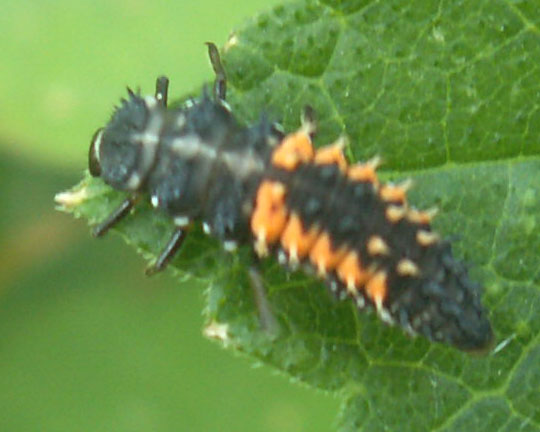 |
25
May 2008
A
Harlequin
Ladybird, Harmonia axyridis succinea,
sat stationary on a Stinging Nettle on the verge of the footpath section
of the Waterworks
Road, Old Shoreham.
I do not seem to have made a note of the first 7-spot Ladybird,Coccinella septempunctata, of the year.
11
October 2007
A
Harlequin
Ladybird, Harmonia axyridis succinea,
crawled over the Ivy on the Pixie Path
approach to Mill Hill.
| 8
June 2007
A 7-spot Ladybird, Coccinella septempunctata, spotted on the Buckingham Cutting, north Shoreham. |
 |
| 9
April 2007
In passing I thought the ladybirds on the Alexanders on the Coastal Link Cyclepath just south of the Toll Bridge were the usual 7-spot Ladybirds but when I had a look a the photograph it turned out to be an immigrant alien Harlequin Ladybird, Harmonia axyridis succinea. (TQ 207 059) Harlequin Ladybird Survey |
 |
27
March 2007
Only
occasional 7-spot Ladybirds,
Coccinella
septempunctata, were seen on the Pixie
Path approach to Mill
Hill from the Waterworks Road.
19
March 2007
The
7-spot Ladybird,
Coccinella
septempunctata, are frequently seen around,
all of them on the leaves of Alexanders. They are the only ladybirds
seen.
9 March
2007
A
small (6 mm long) immigrant alien Harlequin
Ladybird, Harmonia axyridis succinea,
was spotted on an Alexander leaf on the Pixie
Path approach to Mill
Hill from the Waterworks Road. (TQ
210 063)
Harlequin
Ladybirds were
introduced to North America in the 1970s as an "environmentally friendly"
alternative to pesticides and quickly swept across the continent, driving
out domestic species and other aphid-eating bugs. Harlequins
are
more adaptable than most ladybird species, living in trees as well as the
ground. In the spring, they out-compete rivals for aphids. Like all ladybirds,
the Harlequin Ladybird
undergoes complete metamorphosis and as such has an egg, larval, pupal
and adult stage. Pre-adult development takes about 14 to 20 days at 25
ºC and adults can begin to lay eggs after
5 days. A single female can lay over a thousand eggs.
Harlequin
Ladybirds feed most commonly on aphids, but
have a wide food range, also feeding on scale insects, adelgids, the eggs
and larvae of butterflies and moths, many other small insects, including
other ladybirds, pollen, nectar, and sugary fluids, including honeydew
and the juice from ripe fruits.
UK
Ladybird Survey
Harlequin
Ladybird Survey
 2
March 2007
2
March 2007
In
a brief burst of early afternoon sunshine, I came across my first 7-spot
Ladybird,
Coccinella septempunctata,
of the year on the leaves of Alexanders at
the top of Chanctonbury Drive (SE of the bridge to Mill
Hill). I saw at least a dozen, some in pairs, without trying to look
for them.
2 February
2007
The
first 7-spot Ladybird,
Coccinella
septempunctata, of the year is spotted
on Lancing Manor Allotments.
16
October 2006
7-spot
Ladybirds, Coccinella
septempunctata, were frequently seen on
the wasteland. This common species is not mentioned in middle of the year,
because it is not though newsworthy enough. Its observation is a bit erratic
and perhaps worth a study if time allows.
15
October 2006
Harlequin
Ladybirds, Harmonia axyridis (larvae
and adults, colour forms succinea
and spectabilis),
were discovered in large numbers in Portslade. Although only ten were actually
seen, there could have been hundreds or even thousands in the trees and
bushes on Portslade
Recreation Ground (TQ 258 056).
 |
 |
The Harlequin Ladybird is an alien invasive species that has spread across England from the south-east since 2004, when it was first recorded in Sussex.
| 27
May 2006
This little red beetle (not a ladybird) was spotted on the Sompting Brooks, where the gardens meet the wild strouds. It is only about 6 mm long. Report
& Photograph
by June Bratton
Identification
by Malcolm Storey (BioImages)
on the British
Insects Yahoo Group
|
 |
 |
21
April 2006
I spotted my first alien Harlequin Ladybird, Harmonia axyridis spectabilis, on a flower in a north Shoreham garden. The white facial markings are diagnostic. Harlequin Ladybird Survey Originally misidentified as a Kidney-spot Ladybird, Chilocorus renipustulatus; it was only correctly identified on 16 October 2006. 7-spot Ladybirds were frequently seen on wasteland and in gardens. |
8 July 2005
It was just a tiny flash of orange that ended up in a spider's web until it crawled on to my rucksack. This ladybird
 7
June 2005
7
June 2005
Dovecote
Bank
There
was a small red ladybird
and it was so small that without my magnifying glass handy I could not
even see how many spots it had. The photograph was out of focus because
of its small size. It was Subcoccinella
vigintiquattuorpunctata (Linnaeus, 1758)
the 24-spot Ladybird.
5 May
2005
The
small 24-spot Ladybird, Subcoccinella
vigintiquattuorpunctata, was recorded
from McIntyres Field near Lancing Ring.
| 1
May 2005
14-spot
Ladybird,
Location: Waterworks Road 7
May 2005
One was recorded on Slonk Hill Cutting (south) on 31 July 2005. |
 |
23
April 2005
An
Orange
Ladybird,
Halyzia
sedecimguttata was spotted on a Bramble leaf in Mash
Barn Lane, Lancing.
10
April 2005
On
the
south-facing
A27
road embankment north of the Dovecote
Estate, Shoreham, a 7-spot Ladybird,
Coccinella
septempunctata, was on the wing: after crawling around a bit, it flew
away.
19
March 2005
 |
|
There were dozens of 7-spot Ladybirds, Coccinella septempunctata, on the Stinging Nettles north of Lancing Manor. Unlike the ladybirds of three days ago in Old Shoreham, these ladybirds were lively and appeared to be attempting to mate. |
16 March 2005
The first ladybird of the year was a 7-spot Ladybird, Coccinella septempunctata, in the Butterfly Copse (near the Waterworks Road).
18
July 2004
As
the sun struggled to come out, so did the flying insects in the back garden
in The Drive, Shoreham:
|
The small yellow 14-spot Ladybird, Propylea quattuordecimpunctata, flew away rapidly when disturbed. |
 |
 25
May 2004
25
May 2004
Beeding
Hill.
A small
ladybird on a Dove's-foot Crane's-bill (Geranium)
was
a tiny (2 mm long) yellow beetle with black spots. The most likely species
is the Sixteen-spot Ladybird,
Tytthaspis
sedecimpunctata.
British
Insects Yahoo Group
The
Coleopterist
British
Beetles Yahoo Group
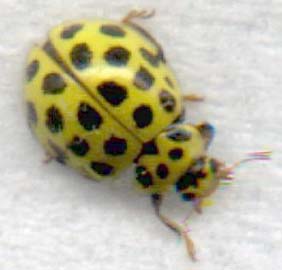
15
April 2004
A
7-spot
Ladybird,
Coccinella septempunctata,
was noted with Germander Speedwell on the Waterworks
Road.
 12
April 2004
12
April 2004
Clearing
out my shed in south Lancing (TQ
186 044) produced a small
ladybird that was black with just the two visible red spots. This seems
to be the Kidney-spot Ladybird,
Chilocorus
renipustulatus.
Ladybird
Images
6
March 2004
In
the foliage and soil a few creatures were active in my south Lancing garden
(TQ
186 044), the most colourful was a 22
spot Ladybird,
Psyllobora vigintiduopunctata,
a mere 4 mm long.
Lancing
Beetles
11
July 2002
In
the wooded fringes of Lancing Ring, I noticed
a colourful multi-spotted yellow 22 spot
Ladybird,
Psyllobora vigintiduopunctata.
Checklist
of UK Recorded Coccinellidae
 Adur
Insect Links:
Adur
Insect Links:
Bumblebees
Hoverflies
Butterflies
Solitary
Bees
Bees
& Wasps
Flies
Beetles
Ladybirds
Moths
Grasshoppers
& Crickets
Damselflies
&
Dragonflies

